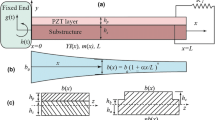Abstract
This research proposes a new design for a cantilever-type piezoelectric energy harvester in which a free tip is excited by any rotary motion of mechanical devices. A coupled field finite element model for the harvester is constructed using ANSYS and verification study is performed. Design optimization on the shape of the harvester is done to maximize output power. The design optimization result shows excellent performance when compared to a simple rectangular cantilever or the well-known tapered cantilever. The design results are prototyped and their improved performances are experimentally attested.
Similar content being viewed by others
References
S. Roundy, P. K. Wright and J. M. Rabaey, Energy scavenging for wireless sensor networks with special focus on vibrations, Kluwer Academic Publishers (2004).
J. Kymissis, C. Kendall, J. Paradiso and N. Gershenfeld, Parasitic power harvesting in shoes, Proc. 2nd IEEE Int. Conf. Wearable Computing, California, USA (1998) 132–139.
N. S. Shenck and J. A. Paradiso, Energy scavenging with shoe-mounted piezoelectrics, IEEE Micro., 21 (2001) 30–42.
E. S. Leland, E. M. Lai and P. K. Wright, A self-powered wireless sensor for indoor environmental monitoring, WNCG Conference, Austin, Texas, USA (2004).
J. Feenstra, J. Granstrom and H. Sodano, Energy harvesting through a backpack employing a mechanically amplified piezoelectric stack, Mechanical Systems and Signal Processing, 22 (2008) 721–734.
N. Elvin, A. Elvin and D. H. Choi, A self-powered damage detection sensor, J. Strain Analysis, 38(2) (2003) 115–124.
P. Glynne-Jones, S. P. Beeby and N. M. White, Towards a piezoelectric vibration powered microgenerator, IEE Proc.-Sci. Meas. Technol., 148 (2001) 68–72.
S. Roundy, E. S. Leland, J. Baker, E. Carleton, E. Reilly, E. Lai, B. Otis, J. M. Rabaey, P. K. Wright and V. Sundararajan, Improving power output for vibration-based energy scavengers, IEEE Pervasive Comput., 4 (2005) 28–36.
F. Goldschmidtboeing and P. Woias, Characterization of different beam shapes for piezoelectric energy harvesting, J. Micromech. Microeng., 18(10) (2008) 104013.
P. Simon and S. Yves, Improving the performance of a piezoelectric energy harvester using a variable thickness beam, Smart materials & structures, 19(10) (2010) 105020.
B. Zheng, C. J. Chang and H. C. Gea, Topology optimization for piezoelectric energy harvesting devices, 7th World Congress on Structural and Multidisciplinary Optimization, Seoul, Korea (2007) 1677–1685.
F. Khameneifar, M. Moallem and S. Arzanpour, Modeling and analysis of a piezoelectric energy scavenger for rotary motion applications, Journal of vibration and acoustics, 133(1) (2011) 011005.
Y. Hashimoto, O. Takahashi, H. Miyazaki, T. Funasaka and M. Furuhata, Power generation method and power generator using a piezoelectric element, and electronic device using the power, United States Patent No. 5835996 (1998).
C. B. Carroll, Piezoelectric rotary electrical energy generator, United States Patent No. US 6194815 B1 (2001).
C. Chen, R. A. Islam and S. Priya, Electric energy generator, ieee transactions on ultrasonics, Ferroelectrics and Frequency Control, 53(3) (2006) 656–661.
A. Erturk and D. J. Inman, An experimentally validated bimorph cantilever model for piezoelectric energy harvesting from base excitations, Smart Materials and Structures, 18 (2009) 025009.
Measurement Specialties Inc., Piezo Film Sensors Technical Manual, (cited 19 October 2010) Available from: http://www.media.mit.edu/resenv/classes/MAS836/Readings/MSI-techman.pdf.
MatWeb, (cited 11 March 2011) Available from: http://www.matweb.com/search/DataSheet.aspx?MatGUID=a696bdcdff6f41dd98f8eec3599eaa20.
M. L. James, G. M. Smith, J. C. Wolfold and P. W. Whaley, Vibration of Mechanical and Structural Systems, Harper Collins College Publishers, New York, USA (1994).
A. D. Belegundu and T. R. Chandrupatla, Optimization Concepts and Applications in Engineering, Prentice Hall, New Jersey, USA (1999).
Author information
Authors and Affiliations
Corresponding author
Additional information
This paper was recommended for publication in revised form by Associate Editor Jeong Sam Han
Juil Park received his B.S. in Mechanical Engineering from Hanyang University, Korea, in 2006, and M.S. in Mechanical Engineering from Korea Advanced Institute of Science and Technology (KAIST), Korea, in 2008. His interests are strength and fatigue analysis of structure and energy harvester design
Soobum Lee received his Ph.D in Mechanical Engineering from Korea Advanced Institute of Science and Technology (KAIST), Korea, in 2007. Currently he is a research assistant professor at the department of Aerospace and Mechanical Engineering in the University of Notre Dame, USA. His main research interests include energy harvester design, topology optimization, robust design, and reliability based design optimization. His recent research on piezoelectric energy harvesting has been awarded as a 2009 highlight of collections by smart materials and structures (IOP publishing) and acknowledged by several science news websites including PhysOrg.com and EETweb.com.
Byung Man Kwak received his B.S. in Mechanical Engineering from Seoul National University in 1967, and Ph.D in 1974 from the University of Iowa. Professor Kwak is currently Samsung Chair Professor in the Department of Mechanical Engineering of KAIST and Director of KAIST Mobile Harbor Project. His areas of interest are optimal design and applications. He is former President of the Korean Society of Mechanical Engineers, a fellow of the American Society of Mechanical Engineers, member of the Korean Academy of Science and Technology and the National Academy of Engineering of Korea. He was awarded the Korea Engineering Prize in 2005, a presidential award.
Rights and permissions
About this article
Cite this article
Park, J., Lee, S. & Kwak, B.M. Design optimization of piezoelectric energy harvester subject to tip excitation. J Mech Sci Technol 26, 137–143 (2012). https://doi.org/10.1007/s12206-011-0910-1
Received:
Revised:
Accepted:
Published:
Issue Date:
DOI: https://doi.org/10.1007/s12206-011-0910-1




